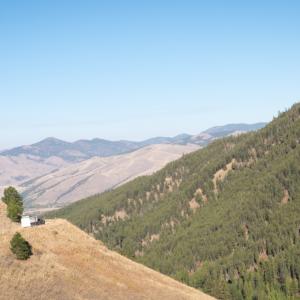My love affair with Miss Dixie, my Chevy Silverado 2500HD Duramax diesel pickup with an Allison towing transmission, took me completely by surprise.
I am not a motor head. For most of my life, I really didn’t care much about vehicles. It mattered not to me how they run; I could have cared less about what’s under their hoods. Television ads for pickups have always struck me as an excess of testosterone-driven banality. I shudder at the off-road scenes of pickups tearing up the environment – wheels turning, mud flying, birds scattering, as some young buck extols the myth of the freedom and power that is his, as he careens his pickup truck across the western landscape, singing a cowboy song.
However, anyone who is serious about horseback riding in Montana’s backcountry soon learns that it is inextricably interwoven with driving a truck and pulling a lot of weight – a lot of emotionally important, living weight. Towing a trailer is a reality.

Lacking both the interest and the skills acquired from afternoons spent with a bunch of guys in garages tuning up engines and jacking up frames for dragging on Main Street, most horsewomen are reluctant to learn the basics. We don’t care if it’s fancy, we don’t need roll bars and fog lights, and our identity has nothing to do with the horsepower at our command. We want a SAFE, DEPENDABLE, DRIVABLE machine.
The problem with a laissez-faire attitude towards truck ownership is that it can get you into trouble – serious, life threatening trouble. Pulling the wrong load with the wrong vehicle can take you right into the great beyond.

Heavy loads simply up the driving ante. High speeds, steep terrain, narrow, washed out or soft shouldered mountain roads, Montana’s famous gumbo mud, and winter’s snow and ice can spell disaster. My adventurous spirit and my often misplaced know-it-all attitude has given me more than my share of hair raising moments while learning the ins and outs of towing a trailer with horses.
Mud as slippery as snot and up to my axles on a long road into the Beartooth Mountains – check. Trying to back a fully loaded 4-horse trailer down a mountain logging road only to have the trailer pull my truck off the road – check. Jackknifing the trailer on a hidden patch of spring ice – check. Running out of gas along the Rocky Mountain Front and facing the irony of pulling over in front of a derrick pumping oil out of the ground – check. Flying down Pipestone Pass at too high a speed and holding on for dear life as the weight behind me pushed my truck beyond the breaking capacity – check. (Note: those runaway lanes on Montana’s mountain passes aren’t there for picnicking)!
I have learned a few lessons – the hard way. Now I can back a six-horse trailer down a mountain road with greater ease than I can parallel park my car in downtown Missoula. All of this has made me a much more cautious and skilled driver, and it has turned me into a very discriminating truck consumer.
Miss Dixie did not just fall into my life. She was sought and carefully evaluated before I brought her home to meet the family. My initial reluctance with vehicles practically turned into an obsession for researching the desired attributes when I went to purchase a brand spanking new truck. Towing capacity, power, fuel capacity, turning radius, length of wheelbase, and transmission gear ratios became key elements in my search for the right vehicle.

Then, there she was – on the lot of Karl Tyler Chevrolet. A sleek, black beauty with all the power to take me up any mountain road, with a “smart” towing transmission to bring me down those mountain roads just as safely. A short wheelbase for tight turnarounds, yet roomy enough for five passengers—with comfortable seats and a great radio to boot. Yes, I admit it. I am in love with my truck. We are inseparable. You can call us the Montana Dixie Chicks!
Now I am just waiting for those TV ads to feature a frumpy old horsewomen like me ready to take on the world with the likes of Miss Dixie! Or perhaps I will settle for a great country western song about an old Montana cowgirl and her beloved truck – I think I’ll call up Shane Clouse and ask him to get right on that.
 SuzAnne Miller is the owner of Dunrovin Ranch. A fourth-generation Montanan, SuzAnne grew up roaming the mountains and fishing the streams of western Montana. Her love of nature, animals, science, and education prompted her to create the world’s first cyber ranch where live web cameras bring Dunrovin’s wildlife and ranch life to internet users across the globe.
SuzAnne Miller is the owner of Dunrovin Ranch. A fourth-generation Montanan, SuzAnne grew up roaming the mountains and fishing the streams of western Montana. Her love of nature, animals, science, and education prompted her to create the world’s first cyber ranch where live web cameras bring Dunrovin’s wildlife and ranch life to internet users across the globe.
You can find her blog at: http://dunrovinranchmontana.com/blog/






 SuzAnne Miller is the owner of Dunrovin Ranch. A fourth-generation Montanan, SuzAnne grew up roaming the mountains and fishing the streams of western Montana. Her love of nature, animals, science, and education prompted her to create the world’s first cyber ranch where live web cameras bring Dunrovin’s wildlife and ranch life to internet users across the globe.
SuzAnne Miller is the owner of Dunrovin Ranch. A fourth-generation Montanan, SuzAnne grew up roaming the mountains and fishing the streams of western Montana. Her love of nature, animals, science, and education prompted her to create the world’s first cyber ranch where live web cameras bring Dunrovin’s wildlife and ranch life to internet users across the globe.